CI6410 - Business Plan: Retail Business - Sophisticated Market Plan
VerifiedAdded on 2023/06/10
|22
|4703
|262
Report
AI Summary
This business plan outlines the launch of "Sophisticated Market," a retail supermarket. It details the new venture's process, background, and industry structure, including objectives, goals, and market research employing Porter's Five Forces and SWOT analysis. The plan includes a marketing strategy and a believable marketing plan, along with a comprehensive financial plan encompassing budgeted profit and loss, balance sheet, and start-up expenses. The document addresses the competitive landscape, emphasizing innovative approaches to marketing and cost management to achieve a competitive advantage. It also provides a competency matrix for potential directors, highlighting their skills and contributions to decision-making. The aim is to create a brand with customer loyalty by offering quality products at competitive prices.

Running head: BUSINESS PLAN
Business Plan
Name of the Student:
Name of the University:
Author’s Note:
Business Plan
Name of the Student:
Name of the University:
Author’s Note:
Paraphrase This Document
Need a fresh take? Get an instant paraphrase of this document with our AI Paraphraser
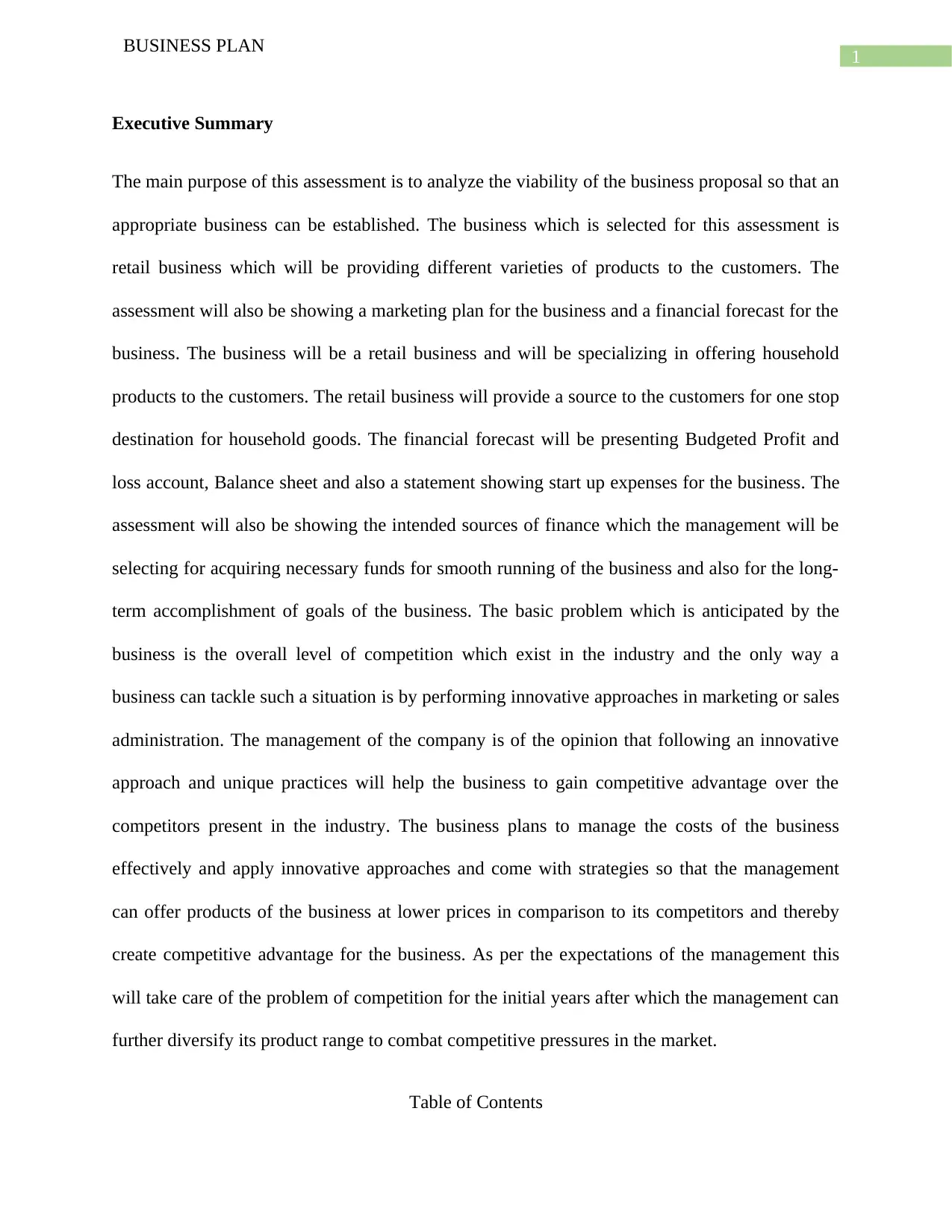
1
BUSINESS PLAN
Executive Summary
The main purpose of this assessment is to analyze the viability of the business proposal so that an
appropriate business can be established. The business which is selected for this assessment is
retail business which will be providing different varieties of products to the customers. The
assessment will also be showing a marketing plan for the business and a financial forecast for the
business. The business will be a retail business and will be specializing in offering household
products to the customers. The retail business will provide a source to the customers for one stop
destination for household goods. The financial forecast will be presenting Budgeted Profit and
loss account, Balance sheet and also a statement showing start up expenses for the business. The
assessment will also be showing the intended sources of finance which the management will be
selecting for acquiring necessary funds for smooth running of the business and also for the long-
term accomplishment of goals of the business. The basic problem which is anticipated by the
business is the overall level of competition which exist in the industry and the only way a
business can tackle such a situation is by performing innovative approaches in marketing or sales
administration. The management of the company is of the opinion that following an innovative
approach and unique practices will help the business to gain competitive advantage over the
competitors present in the industry. The business plans to manage the costs of the business
effectively and apply innovative approaches and come with strategies so that the management
can offer products of the business at lower prices in comparison to its competitors and thereby
create competitive advantage for the business. As per the expectations of the management this
will take care of the problem of competition for the initial years after which the management can
further diversify its product range to combat competitive pressures in the market.
Table of Contents
BUSINESS PLAN
Executive Summary
The main purpose of this assessment is to analyze the viability of the business proposal so that an
appropriate business can be established. The business which is selected for this assessment is
retail business which will be providing different varieties of products to the customers. The
assessment will also be showing a marketing plan for the business and a financial forecast for the
business. The business will be a retail business and will be specializing in offering household
products to the customers. The retail business will provide a source to the customers for one stop
destination for household goods. The financial forecast will be presenting Budgeted Profit and
loss account, Balance sheet and also a statement showing start up expenses for the business. The
assessment will also be showing the intended sources of finance which the management will be
selecting for acquiring necessary funds for smooth running of the business and also for the long-
term accomplishment of goals of the business. The basic problem which is anticipated by the
business is the overall level of competition which exist in the industry and the only way a
business can tackle such a situation is by performing innovative approaches in marketing or sales
administration. The management of the company is of the opinion that following an innovative
approach and unique practices will help the business to gain competitive advantage over the
competitors present in the industry. The business plans to manage the costs of the business
effectively and apply innovative approaches and come with strategies so that the management
can offer products of the business at lower prices in comparison to its competitors and thereby
create competitive advantage for the business. As per the expectations of the management this
will take care of the problem of competition for the initial years after which the management can
further diversify its product range to combat competitive pressures in the market.
Table of Contents
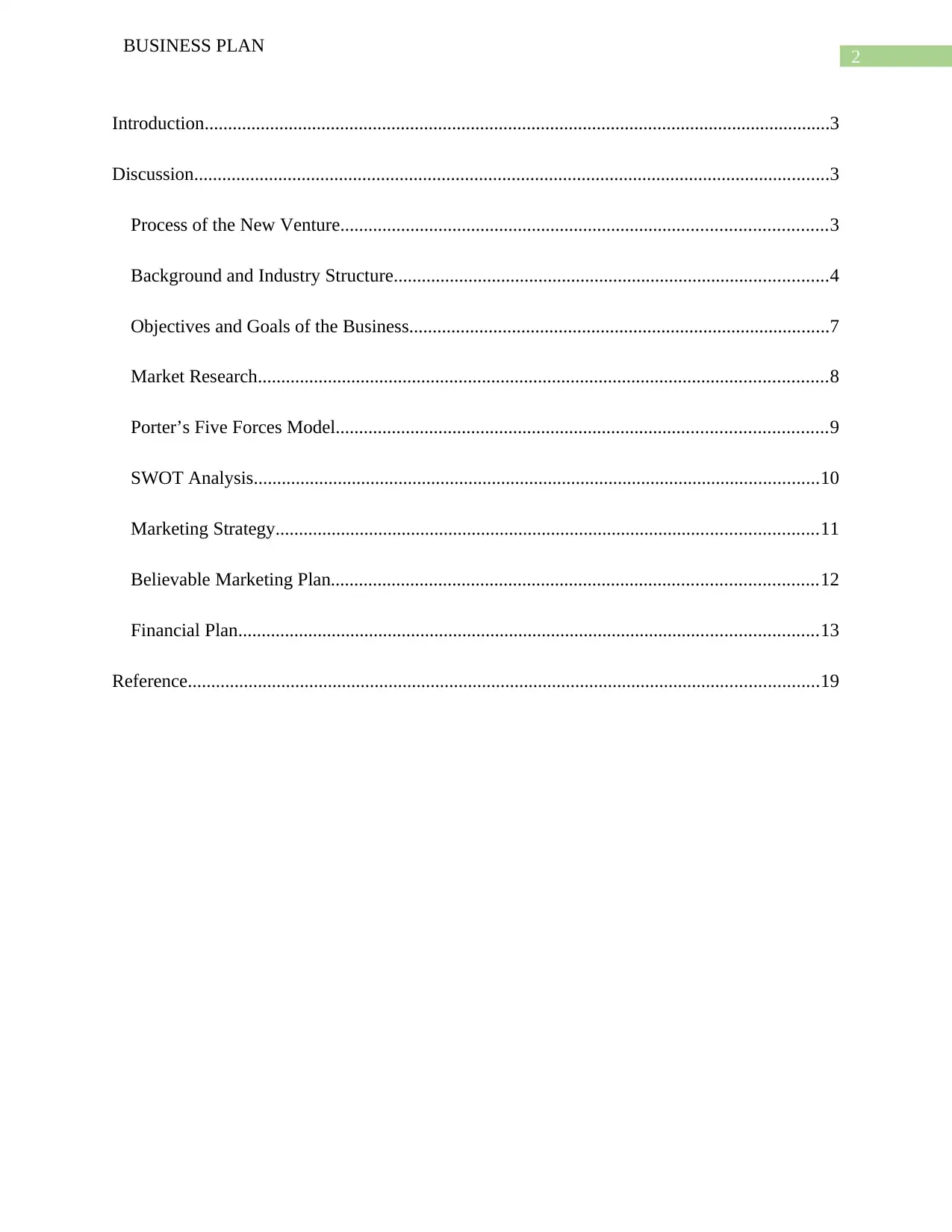
2
BUSINESS PLAN
Introduction......................................................................................................................................3
Discussion........................................................................................................................................3
Process of the New Venture........................................................................................................3
Background and Industry Structure.............................................................................................4
Objectives and Goals of the Business..........................................................................................7
Market Research..........................................................................................................................8
Porter’s Five Forces Model.........................................................................................................9
SWOT Analysis.........................................................................................................................10
Marketing Strategy....................................................................................................................11
Believable Marketing Plan........................................................................................................12
Financial Plan............................................................................................................................13
Reference.......................................................................................................................................19
BUSINESS PLAN
Introduction......................................................................................................................................3
Discussion........................................................................................................................................3
Process of the New Venture........................................................................................................3
Background and Industry Structure.............................................................................................4
Objectives and Goals of the Business..........................................................................................7
Market Research..........................................................................................................................8
Porter’s Five Forces Model.........................................................................................................9
SWOT Analysis.........................................................................................................................10
Marketing Strategy....................................................................................................................11
Believable Marketing Plan........................................................................................................12
Financial Plan............................................................................................................................13
Reference.......................................................................................................................................19
⊘ This is a preview!⊘
Do you want full access?
Subscribe today to unlock all pages.

Trusted by 1+ million students worldwide
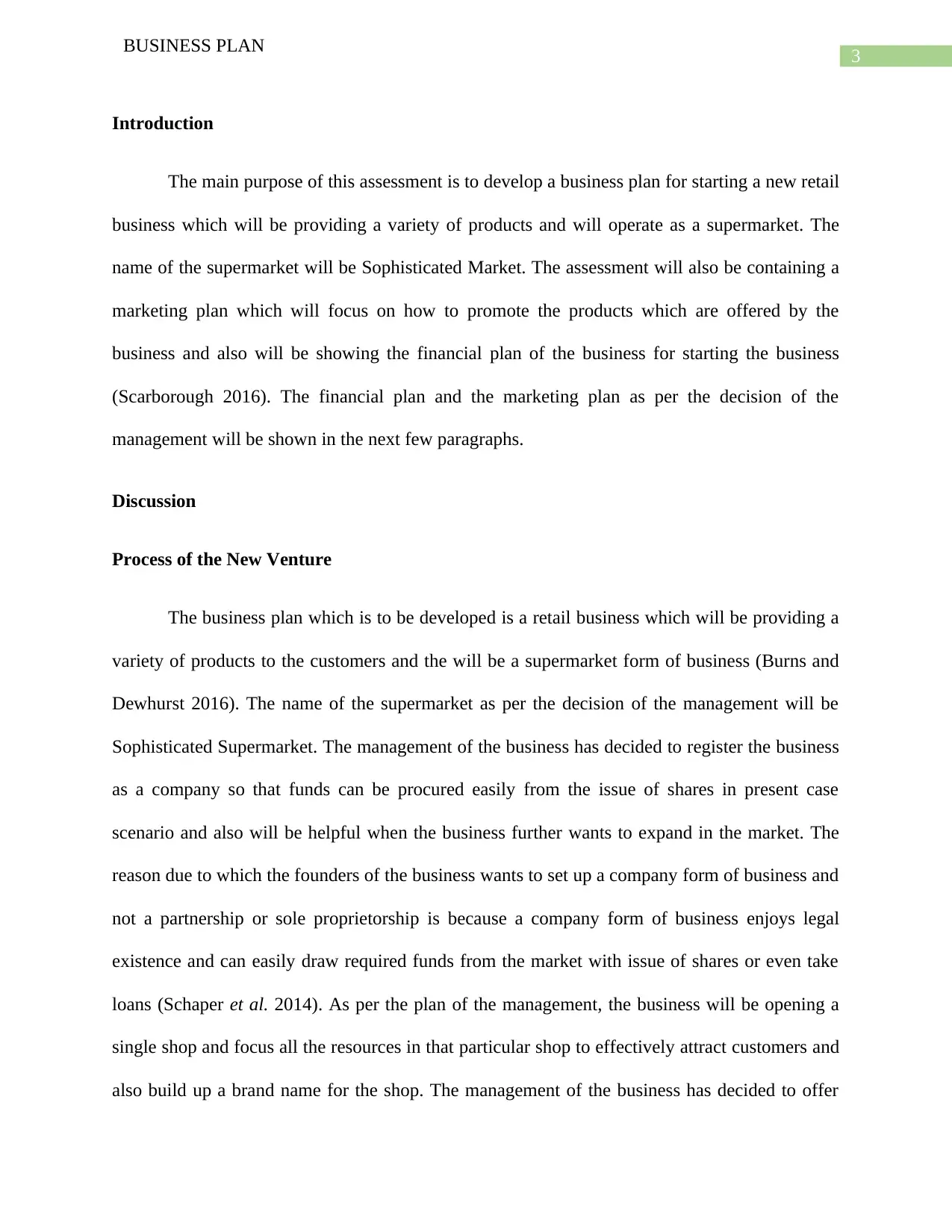
3
BUSINESS PLAN
Introduction
The main purpose of this assessment is to develop a business plan for starting a new retail
business which will be providing a variety of products and will operate as a supermarket. The
name of the supermarket will be Sophisticated Market. The assessment will also be containing a
marketing plan which will focus on how to promote the products which are offered by the
business and also will be showing the financial plan of the business for starting the business
(Scarborough 2016). The financial plan and the marketing plan as per the decision of the
management will be shown in the next few paragraphs.
Discussion
Process of the New Venture
The business plan which is to be developed is a retail business which will be providing a
variety of products to the customers and the will be a supermarket form of business (Burns and
Dewhurst 2016). The name of the supermarket as per the decision of the management will be
Sophisticated Supermarket. The management of the business has decided to register the business
as a company so that funds can be procured easily from the issue of shares in present case
scenario and also will be helpful when the business further wants to expand in the market. The
reason due to which the founders of the business wants to set up a company form of business and
not a partnership or sole proprietorship is because a company form of business enjoys legal
existence and can easily draw required funds from the market with issue of shares or even take
loans (Schaper et al. 2014). As per the plan of the management, the business will be opening a
single shop and focus all the resources in that particular shop to effectively attract customers and
also build up a brand name for the shop. The management of the business has decided to offer
BUSINESS PLAN
Introduction
The main purpose of this assessment is to develop a business plan for starting a new retail
business which will be providing a variety of products and will operate as a supermarket. The
name of the supermarket will be Sophisticated Market. The assessment will also be containing a
marketing plan which will focus on how to promote the products which are offered by the
business and also will be showing the financial plan of the business for starting the business
(Scarborough 2016). The financial plan and the marketing plan as per the decision of the
management will be shown in the next few paragraphs.
Discussion
Process of the New Venture
The business plan which is to be developed is a retail business which will be providing a
variety of products to the customers and the will be a supermarket form of business (Burns and
Dewhurst 2016). The name of the supermarket as per the decision of the management will be
Sophisticated Supermarket. The management of the business has decided to register the business
as a company so that funds can be procured easily from the issue of shares in present case
scenario and also will be helpful when the business further wants to expand in the market. The
reason due to which the founders of the business wants to set up a company form of business and
not a partnership or sole proprietorship is because a company form of business enjoys legal
existence and can easily draw required funds from the market with issue of shares or even take
loans (Schaper et al. 2014). As per the plan of the management, the business will be opening a
single shop and focus all the resources in that particular shop to effectively attract customers and
also build up a brand name for the shop. The management of the business has decided to offer
Paraphrase This Document
Need a fresh take? Get an instant paraphrase of this document with our AI Paraphraser
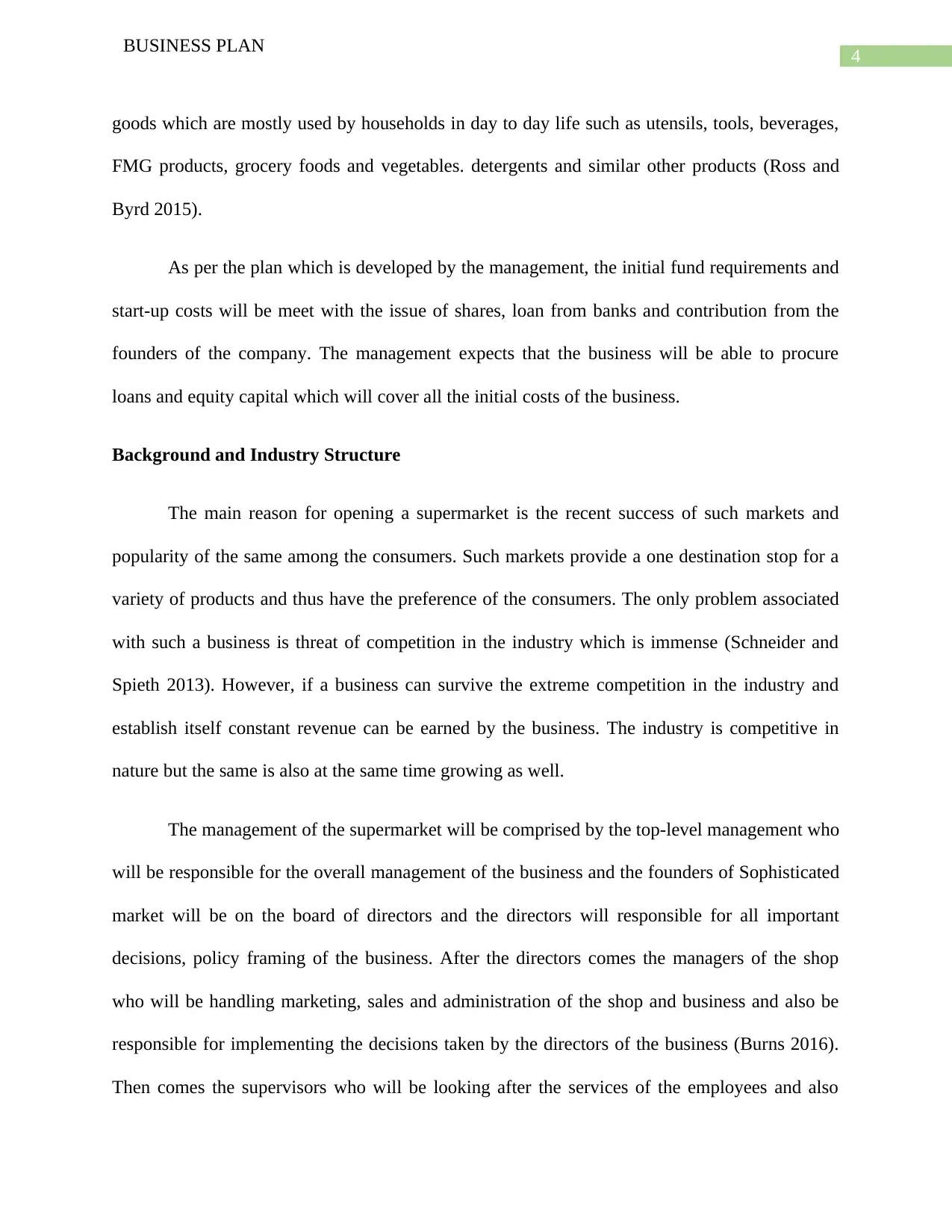
4
BUSINESS PLAN
goods which are mostly used by households in day to day life such as utensils, tools, beverages,
FMG products, grocery foods and vegetables. detergents and similar other products (Ross and
Byrd 2015).
As per the plan which is developed by the management, the initial fund requirements and
start-up costs will be meet with the issue of shares, loan from banks and contribution from the
founders of the company. The management expects that the business will be able to procure
loans and equity capital which will cover all the initial costs of the business.
Background and Industry Structure
The main reason for opening a supermarket is the recent success of such markets and
popularity of the same among the consumers. Such markets provide a one destination stop for a
variety of products and thus have the preference of the consumers. The only problem associated
with such a business is threat of competition in the industry which is immense (Schneider and
Spieth 2013). However, if a business can survive the extreme competition in the industry and
establish itself constant revenue can be earned by the business. The industry is competitive in
nature but the same is also at the same time growing as well.
The management of the supermarket will be comprised by the top-level management who
will be responsible for the overall management of the business and the founders of Sophisticated
market will be on the board of directors and the directors will responsible for all important
decisions, policy framing of the business. After the directors comes the managers of the shop
who will be handling marketing, sales and administration of the shop and business and also be
responsible for implementing the decisions taken by the directors of the business (Burns 2016).
Then comes the supervisors who will be looking after the services of the employees and also
BUSINESS PLAN
goods which are mostly used by households in day to day life such as utensils, tools, beverages,
FMG products, grocery foods and vegetables. detergents and similar other products (Ross and
Byrd 2015).
As per the plan which is developed by the management, the initial fund requirements and
start-up costs will be meet with the issue of shares, loan from banks and contribution from the
founders of the company. The management expects that the business will be able to procure
loans and equity capital which will cover all the initial costs of the business.
Background and Industry Structure
The main reason for opening a supermarket is the recent success of such markets and
popularity of the same among the consumers. Such markets provide a one destination stop for a
variety of products and thus have the preference of the consumers. The only problem associated
with such a business is threat of competition in the industry which is immense (Schneider and
Spieth 2013). However, if a business can survive the extreme competition in the industry and
establish itself constant revenue can be earned by the business. The industry is competitive in
nature but the same is also at the same time growing as well.
The management of the supermarket will be comprised by the top-level management who
will be responsible for the overall management of the business and the founders of Sophisticated
market will be on the board of directors and the directors will responsible for all important
decisions, policy framing of the business. After the directors comes the managers of the shop
who will be handling marketing, sales and administration of the shop and business and also be
responsible for implementing the decisions taken by the directors of the business (Burns 2016).
Then comes the supervisors who will be looking after the services of the employees and also
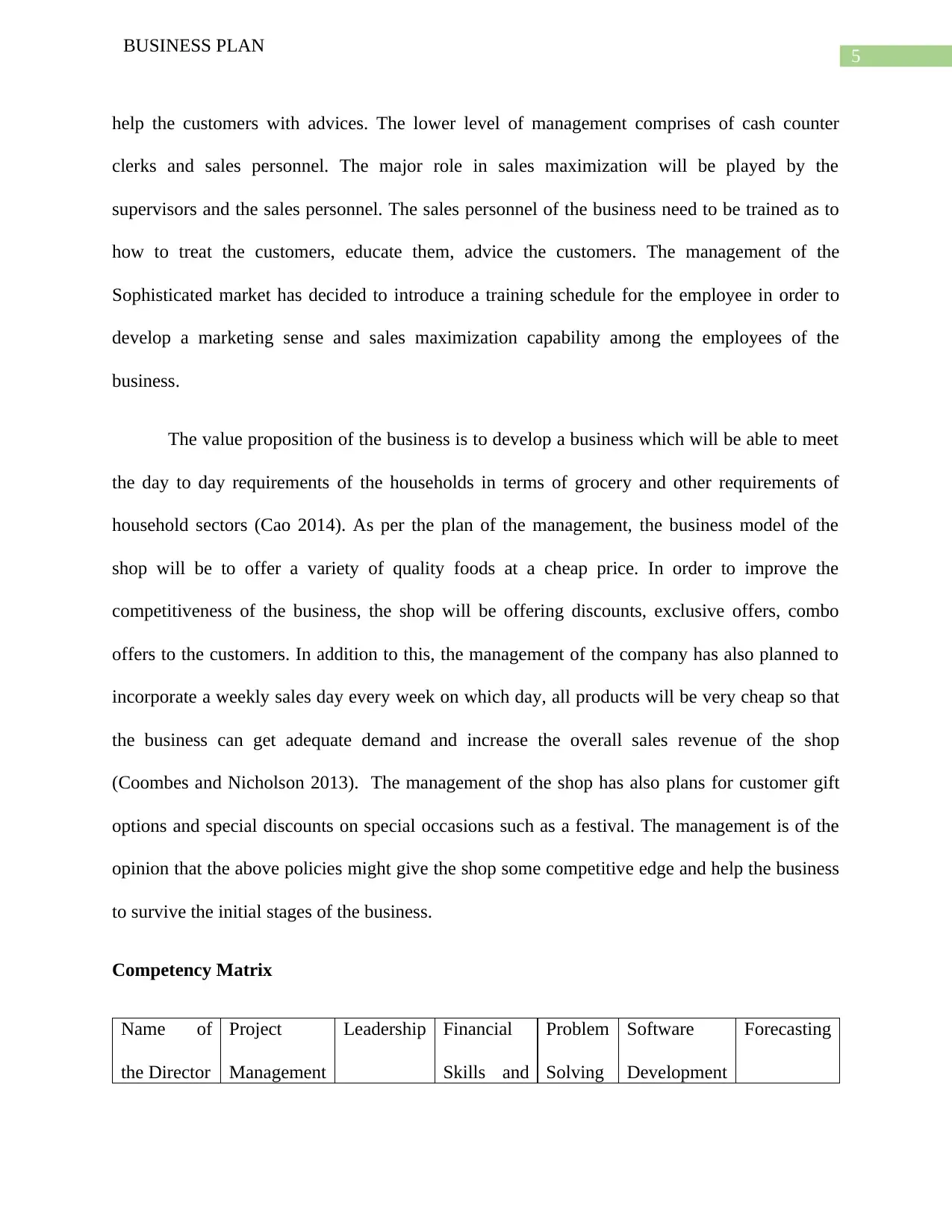
5
BUSINESS PLAN
help the customers with advices. The lower level of management comprises of cash counter
clerks and sales personnel. The major role in sales maximization will be played by the
supervisors and the sales personnel. The sales personnel of the business need to be trained as to
how to treat the customers, educate them, advice the customers. The management of the
Sophisticated market has decided to introduce a training schedule for the employee in order to
develop a marketing sense and sales maximization capability among the employees of the
business.
The value proposition of the business is to develop a business which will be able to meet
the day to day requirements of the households in terms of grocery and other requirements of
household sectors (Cao 2014). As per the plan of the management, the business model of the
shop will be to offer a variety of quality foods at a cheap price. In order to improve the
competitiveness of the business, the shop will be offering discounts, exclusive offers, combo
offers to the customers. In addition to this, the management of the company has also planned to
incorporate a weekly sales day every week on which day, all products will be very cheap so that
the business can get adequate demand and increase the overall sales revenue of the shop
(Coombes and Nicholson 2013). The management of the shop has also plans for customer gift
options and special discounts on special occasions such as a festival. The management is of the
opinion that the above policies might give the shop some competitive edge and help the business
to survive the initial stages of the business.
Competency Matrix
Name of
the Director
Project
Management
Leadership Financial
Skills and
Problem
Solving
Software
Development
Forecasting
BUSINESS PLAN
help the customers with advices. The lower level of management comprises of cash counter
clerks and sales personnel. The major role in sales maximization will be played by the
supervisors and the sales personnel. The sales personnel of the business need to be trained as to
how to treat the customers, educate them, advice the customers. The management of the
Sophisticated market has decided to introduce a training schedule for the employee in order to
develop a marketing sense and sales maximization capability among the employees of the
business.
The value proposition of the business is to develop a business which will be able to meet
the day to day requirements of the households in terms of grocery and other requirements of
household sectors (Cao 2014). As per the plan of the management, the business model of the
shop will be to offer a variety of quality foods at a cheap price. In order to improve the
competitiveness of the business, the shop will be offering discounts, exclusive offers, combo
offers to the customers. In addition to this, the management of the company has also planned to
incorporate a weekly sales day every week on which day, all products will be very cheap so that
the business can get adequate demand and increase the overall sales revenue of the shop
(Coombes and Nicholson 2013). The management of the shop has also plans for customer gift
options and special discounts on special occasions such as a festival. The management is of the
opinion that the above policies might give the shop some competitive edge and help the business
to survive the initial stages of the business.
Competency Matrix
Name of
the Director
Project
Management
Leadership Financial
Skills and
Problem
Solving
Software
Development
Forecasting
⊘ This is a preview!⊘
Do you want full access?
Subscribe today to unlock all pages.

Trusted by 1+ million students worldwide
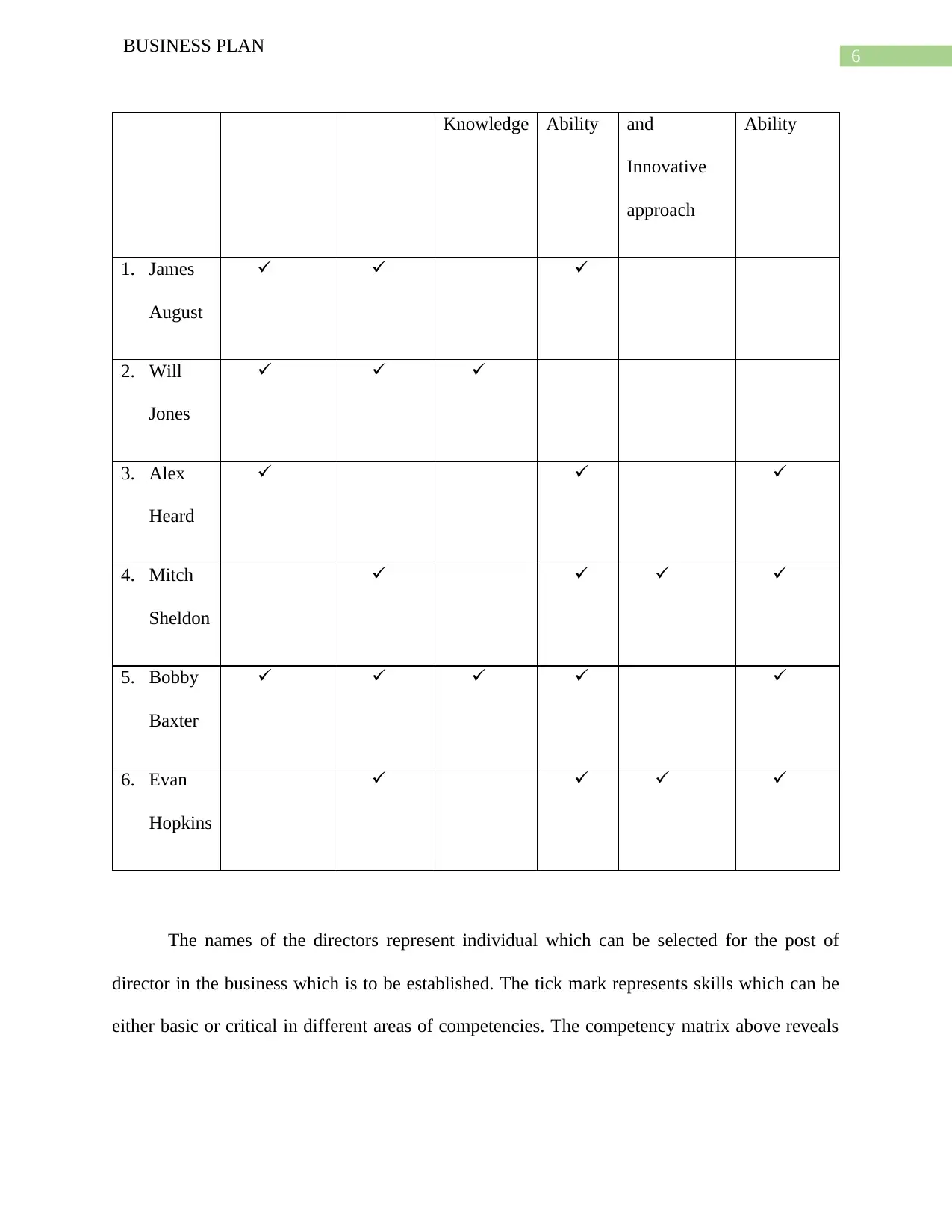
6
BUSINESS PLAN
Knowledge Ability and
Innovative
approach
Ability
1. James
August
2. Will
Jones
3. Alex
Heard
4. Mitch
Sheldon
5. Bobby
Baxter
6. Evan
Hopkins
The names of the directors represent individual which can be selected for the post of
director in the business which is to be established. The tick mark represents skills which can be
either basic or critical in different areas of competencies. The competency matrix above reveals
BUSINESS PLAN
Knowledge Ability and
Innovative
approach
Ability
1. James
August
2. Will
Jones
3. Alex
Heard
4. Mitch
Sheldon
5. Bobby
Baxter
6. Evan
Hopkins
The names of the directors represent individual which can be selected for the post of
director in the business which is to be established. The tick mark represents skills which can be
either basic or critical in different areas of competencies. The competency matrix above reveals
Paraphrase This Document
Need a fresh take? Get an instant paraphrase of this document with our AI Paraphraser
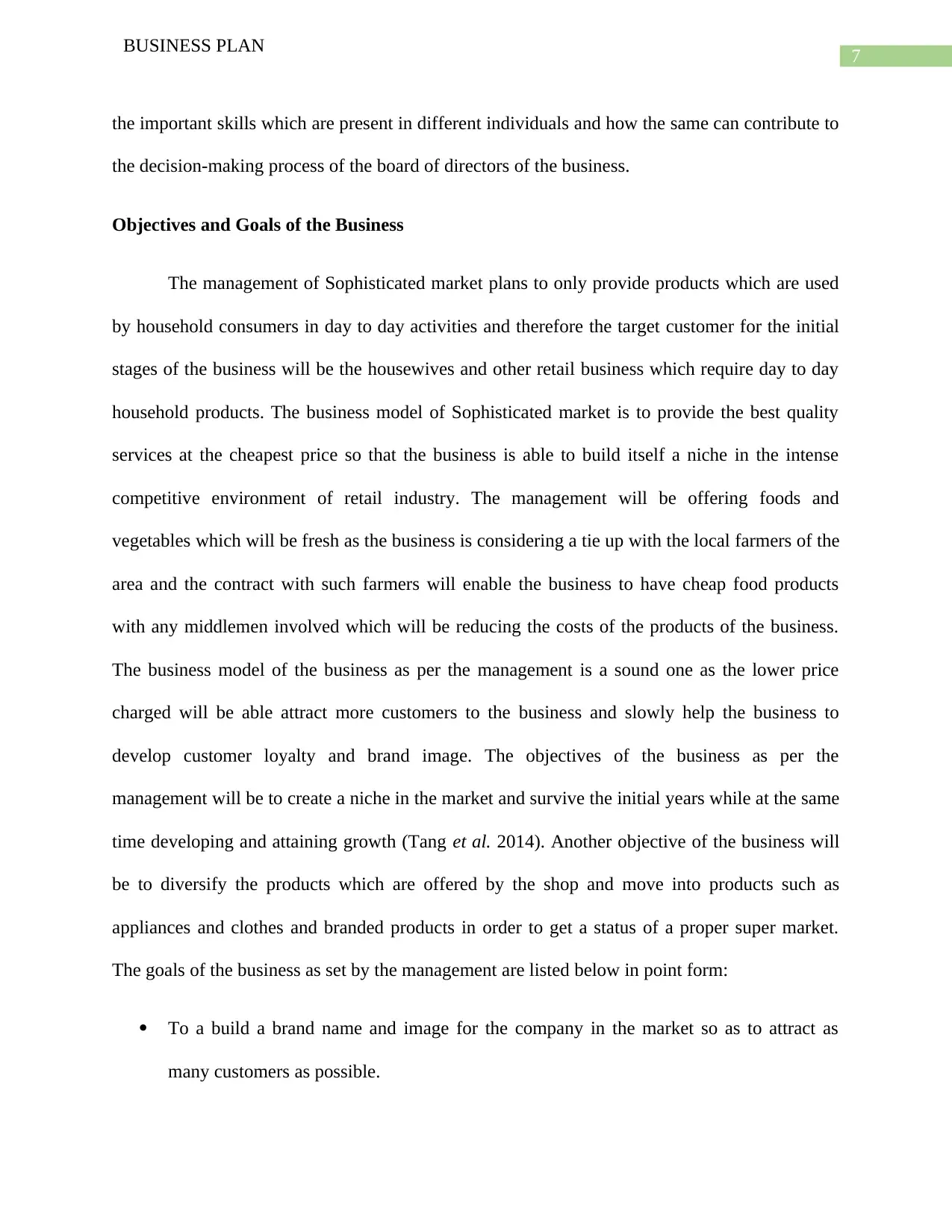
7
BUSINESS PLAN
the important skills which are present in different individuals and how the same can contribute to
the decision-making process of the board of directors of the business.
Objectives and Goals of the Business
The management of Sophisticated market plans to only provide products which are used
by household consumers in day to day activities and therefore the target customer for the initial
stages of the business will be the housewives and other retail business which require day to day
household products. The business model of Sophisticated market is to provide the best quality
services at the cheapest price so that the business is able to build itself a niche in the intense
competitive environment of retail industry. The management will be offering foods and
vegetables which will be fresh as the business is considering a tie up with the local farmers of the
area and the contract with such farmers will enable the business to have cheap food products
with any middlemen involved which will be reducing the costs of the products of the business.
The business model of the business as per the management is a sound one as the lower price
charged will be able attract more customers to the business and slowly help the business to
develop customer loyalty and brand image. The objectives of the business as per the
management will be to create a niche in the market and survive the initial years while at the same
time developing and attaining growth (Tang et al. 2014). Another objective of the business will
be to diversify the products which are offered by the shop and move into products such as
appliances and clothes and branded products in order to get a status of a proper super market.
The goals of the business as set by the management are listed below in point form:
To a build a brand name and image for the company in the market so as to attract as
many customers as possible.
BUSINESS PLAN
the important skills which are present in different individuals and how the same can contribute to
the decision-making process of the board of directors of the business.
Objectives and Goals of the Business
The management of Sophisticated market plans to only provide products which are used
by household consumers in day to day activities and therefore the target customer for the initial
stages of the business will be the housewives and other retail business which require day to day
household products. The business model of Sophisticated market is to provide the best quality
services at the cheapest price so that the business is able to build itself a niche in the intense
competitive environment of retail industry. The management will be offering foods and
vegetables which will be fresh as the business is considering a tie up with the local farmers of the
area and the contract with such farmers will enable the business to have cheap food products
with any middlemen involved which will be reducing the costs of the products of the business.
The business model of the business as per the management is a sound one as the lower price
charged will be able attract more customers to the business and slowly help the business to
develop customer loyalty and brand image. The objectives of the business as per the
management will be to create a niche in the market and survive the initial years while at the same
time developing and attaining growth (Tang et al. 2014). Another objective of the business will
be to diversify the products which are offered by the shop and move into products such as
appliances and clothes and branded products in order to get a status of a proper super market.
The goals of the business as set by the management are listed below in point form:
To a build a brand name and image for the company in the market so as to attract as
many customers as possible.
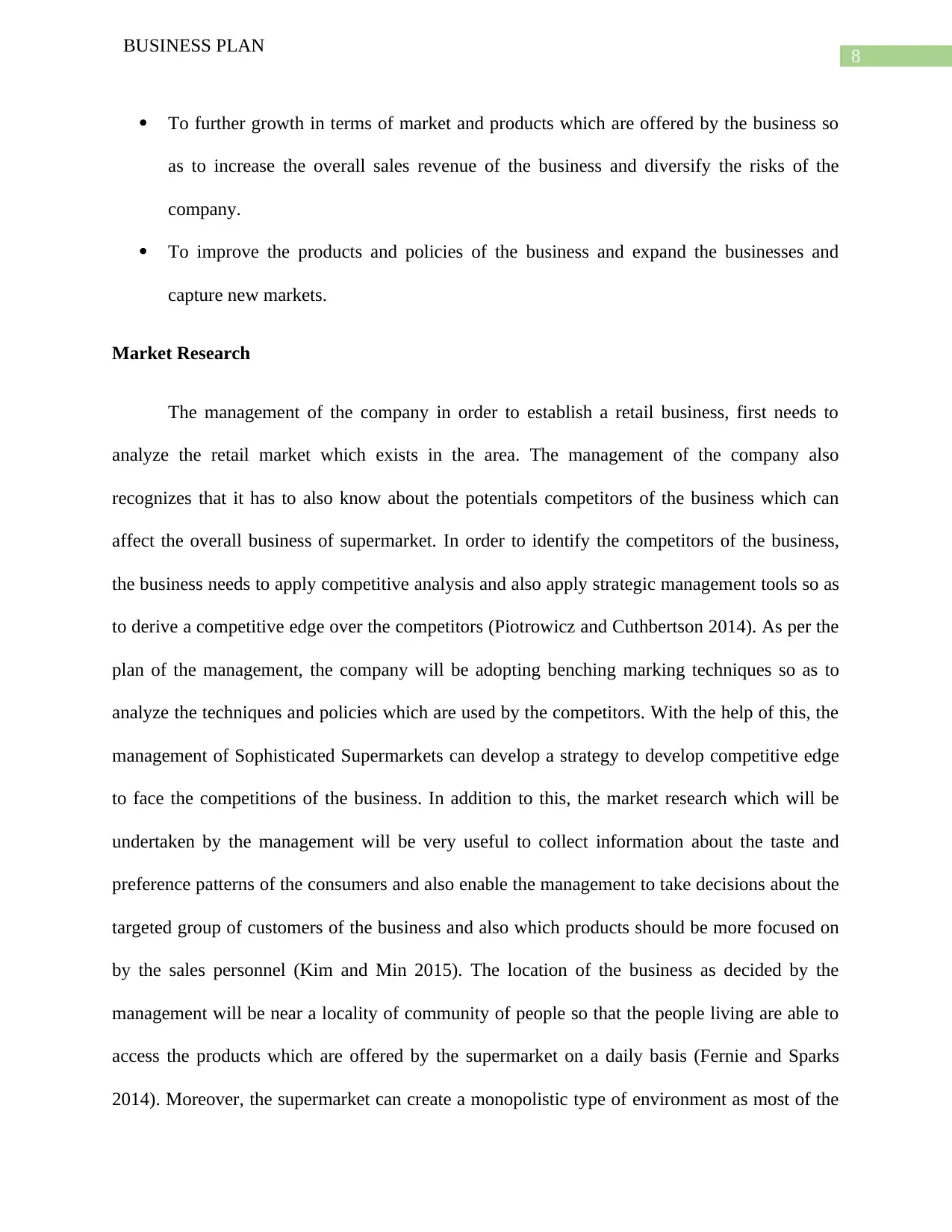
8
BUSINESS PLAN
To further growth in terms of market and products which are offered by the business so
as to increase the overall sales revenue of the business and diversify the risks of the
company.
To improve the products and policies of the business and expand the businesses and
capture new markets.
Market Research
The management of the company in order to establish a retail business, first needs to
analyze the retail market which exists in the area. The management of the company also
recognizes that it has to also know about the potentials competitors of the business which can
affect the overall business of supermarket. In order to identify the competitors of the business,
the business needs to apply competitive analysis and also apply strategic management tools so as
to derive a competitive edge over the competitors (Piotrowicz and Cuthbertson 2014). As per the
plan of the management, the company will be adopting benching marking techniques so as to
analyze the techniques and policies which are used by the competitors. With the help of this, the
management of Sophisticated Supermarkets can develop a strategy to develop competitive edge
to face the competitions of the business. In addition to this, the market research which will be
undertaken by the management will be very useful to collect information about the taste and
preference patterns of the consumers and also enable the management to take decisions about the
targeted group of customers of the business and also which products should be more focused on
by the sales personnel (Kim and Min 2015). The location of the business as decided by the
management will be near a locality of community of people so that the people living are able to
access the products which are offered by the supermarket on a daily basis (Fernie and Sparks
2014). Moreover, the supermarket can create a monopolistic type of environment as most of the
BUSINESS PLAN
To further growth in terms of market and products which are offered by the business so
as to increase the overall sales revenue of the business and diversify the risks of the
company.
To improve the products and policies of the business and expand the businesses and
capture new markets.
Market Research
The management of the company in order to establish a retail business, first needs to
analyze the retail market which exists in the area. The management of the company also
recognizes that it has to also know about the potentials competitors of the business which can
affect the overall business of supermarket. In order to identify the competitors of the business,
the business needs to apply competitive analysis and also apply strategic management tools so as
to derive a competitive edge over the competitors (Piotrowicz and Cuthbertson 2014). As per the
plan of the management, the company will be adopting benching marking techniques so as to
analyze the techniques and policies which are used by the competitors. With the help of this, the
management of Sophisticated Supermarkets can develop a strategy to develop competitive edge
to face the competitions of the business. In addition to this, the market research which will be
undertaken by the management will be very useful to collect information about the taste and
preference patterns of the consumers and also enable the management to take decisions about the
targeted group of customers of the business and also which products should be more focused on
by the sales personnel (Kim and Min 2015). The location of the business as decided by the
management will be near a locality of community of people so that the people living are able to
access the products which are offered by the supermarket on a daily basis (Fernie and Sparks
2014). Moreover, the supermarket can create a monopolistic type of environment as most of the
⊘ This is a preview!⊘
Do you want full access?
Subscribe today to unlock all pages.

Trusted by 1+ million students worldwide
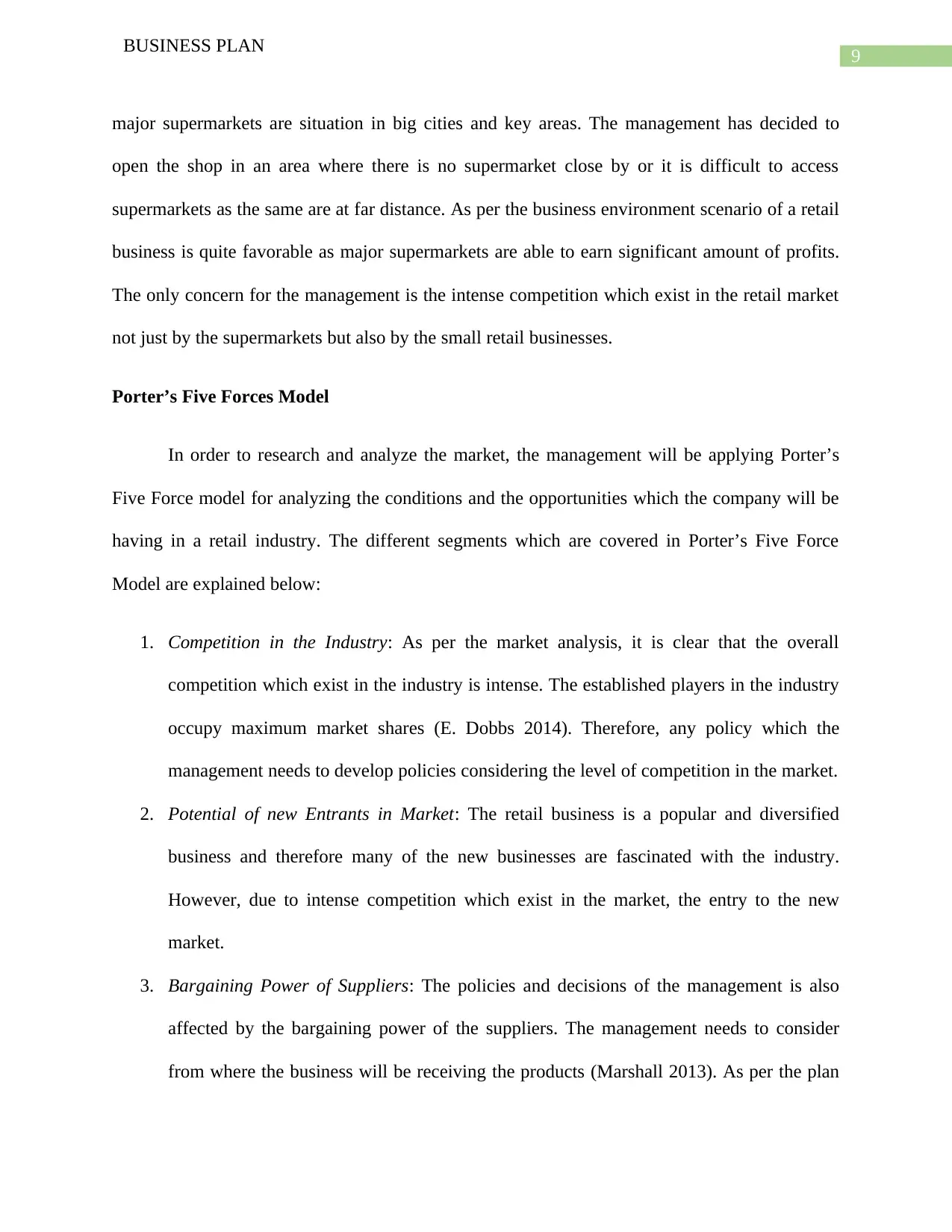
9
BUSINESS PLAN
major supermarkets are situation in big cities and key areas. The management has decided to
open the shop in an area where there is no supermarket close by or it is difficult to access
supermarkets as the same are at far distance. As per the business environment scenario of a retail
business is quite favorable as major supermarkets are able to earn significant amount of profits.
The only concern for the management is the intense competition which exist in the retail market
not just by the supermarkets but also by the small retail businesses.
Porter’s Five Forces Model
In order to research and analyze the market, the management will be applying Porter’s
Five Force model for analyzing the conditions and the opportunities which the company will be
having in a retail industry. The different segments which are covered in Porter’s Five Force
Model are explained below:
1. Competition in the Industry: As per the market analysis, it is clear that the overall
competition which exist in the industry is intense. The established players in the industry
occupy maximum market shares (E. Dobbs 2014). Therefore, any policy which the
management needs to develop policies considering the level of competition in the market.
2. Potential of new Entrants in Market: The retail business is a popular and diversified
business and therefore many of the new businesses are fascinated with the industry.
However, due to intense competition which exist in the market, the entry to the new
market.
3. Bargaining Power of Suppliers: The policies and decisions of the management is also
affected by the bargaining power of the suppliers. The management needs to consider
from where the business will be receiving the products (Marshall 2013). As per the plan
BUSINESS PLAN
major supermarkets are situation in big cities and key areas. The management has decided to
open the shop in an area where there is no supermarket close by or it is difficult to access
supermarkets as the same are at far distance. As per the business environment scenario of a retail
business is quite favorable as major supermarkets are able to earn significant amount of profits.
The only concern for the management is the intense competition which exist in the retail market
not just by the supermarkets but also by the small retail businesses.
Porter’s Five Forces Model
In order to research and analyze the market, the management will be applying Porter’s
Five Force model for analyzing the conditions and the opportunities which the company will be
having in a retail industry. The different segments which are covered in Porter’s Five Force
Model are explained below:
1. Competition in the Industry: As per the market analysis, it is clear that the overall
competition which exist in the industry is intense. The established players in the industry
occupy maximum market shares (E. Dobbs 2014). Therefore, any policy which the
management needs to develop policies considering the level of competition in the market.
2. Potential of new Entrants in Market: The retail business is a popular and diversified
business and therefore many of the new businesses are fascinated with the industry.
However, due to intense competition which exist in the market, the entry to the new
market.
3. Bargaining Power of Suppliers: The policies and decisions of the management is also
affected by the bargaining power of the suppliers. The management needs to consider
from where the business will be receiving the products (Marshall 2013). As per the plan
Paraphrase This Document
Need a fresh take? Get an instant paraphrase of this document with our AI Paraphraser
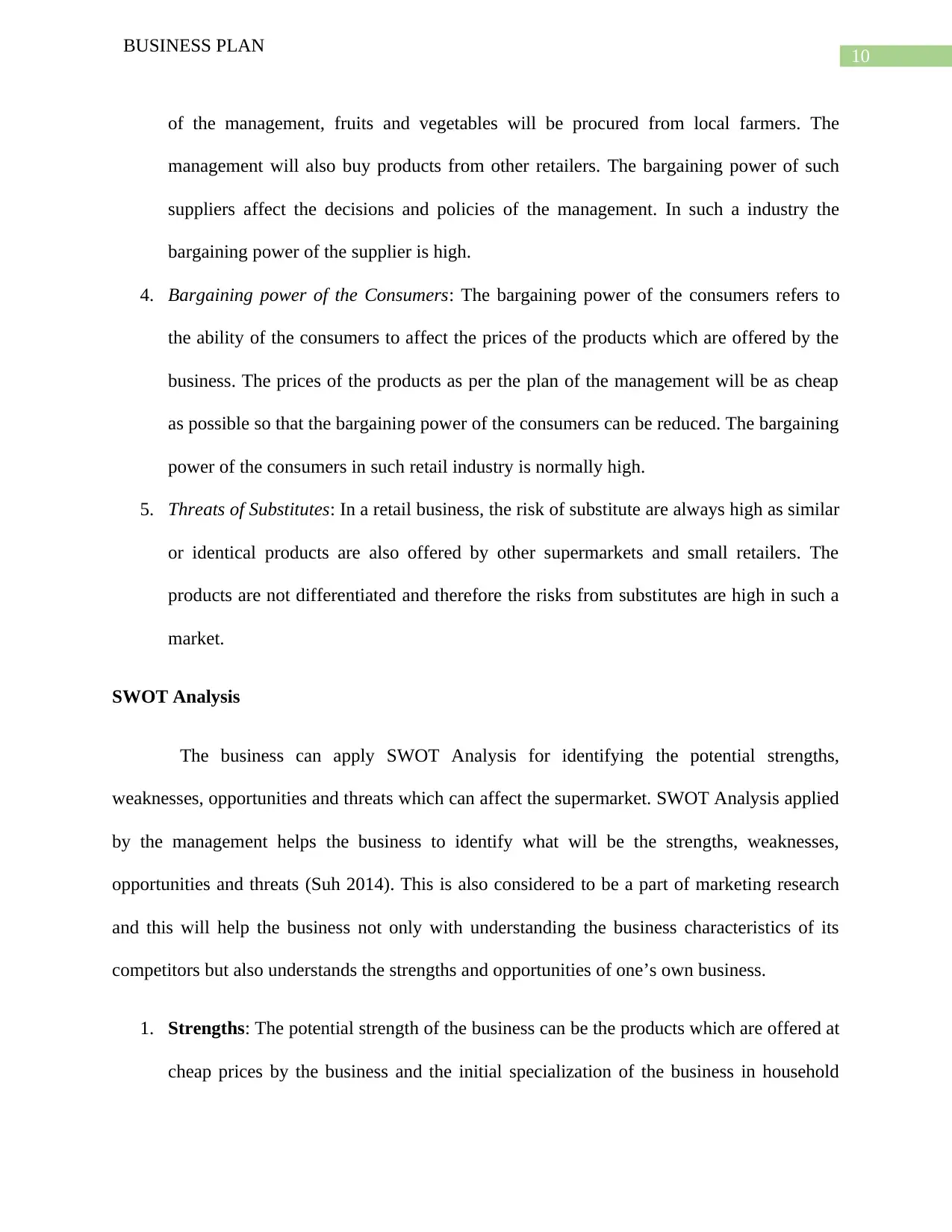
10
BUSINESS PLAN
of the management, fruits and vegetables will be procured from local farmers. The
management will also buy products from other retailers. The bargaining power of such
suppliers affect the decisions and policies of the management. In such a industry the
bargaining power of the supplier is high.
4. Bargaining power of the Consumers: The bargaining power of the consumers refers to
the ability of the consumers to affect the prices of the products which are offered by the
business. The prices of the products as per the plan of the management will be as cheap
as possible so that the bargaining power of the consumers can be reduced. The bargaining
power of the consumers in such retail industry is normally high.
5. Threats of Substitutes: In a retail business, the risk of substitute are always high as similar
or identical products are also offered by other supermarkets and small retailers. The
products are not differentiated and therefore the risks from substitutes are high in such a
market.
SWOT Analysis
The business can apply SWOT Analysis for identifying the potential strengths,
weaknesses, opportunities and threats which can affect the supermarket. SWOT Analysis applied
by the management helps the business to identify what will be the strengths, weaknesses,
opportunities and threats (Suh 2014). This is also considered to be a part of marketing research
and this will help the business not only with understanding the business characteristics of its
competitors but also understands the strengths and opportunities of one’s own business.
1. Strengths: The potential strength of the business can be the products which are offered at
cheap prices by the business and the initial specialization of the business in household
BUSINESS PLAN
of the management, fruits and vegetables will be procured from local farmers. The
management will also buy products from other retailers. The bargaining power of such
suppliers affect the decisions and policies of the management. In such a industry the
bargaining power of the supplier is high.
4. Bargaining power of the Consumers: The bargaining power of the consumers refers to
the ability of the consumers to affect the prices of the products which are offered by the
business. The prices of the products as per the plan of the management will be as cheap
as possible so that the bargaining power of the consumers can be reduced. The bargaining
power of the consumers in such retail industry is normally high.
5. Threats of Substitutes: In a retail business, the risk of substitute are always high as similar
or identical products are also offered by other supermarkets and small retailers. The
products are not differentiated and therefore the risks from substitutes are high in such a
market.
SWOT Analysis
The business can apply SWOT Analysis for identifying the potential strengths,
weaknesses, opportunities and threats which can affect the supermarket. SWOT Analysis applied
by the management helps the business to identify what will be the strengths, weaknesses,
opportunities and threats (Suh 2014). This is also considered to be a part of marketing research
and this will help the business not only with understanding the business characteristics of its
competitors but also understands the strengths and opportunities of one’s own business.
1. Strengths: The potential strength of the business can be the products which are offered at
cheap prices by the business and the initial specialization of the business in household
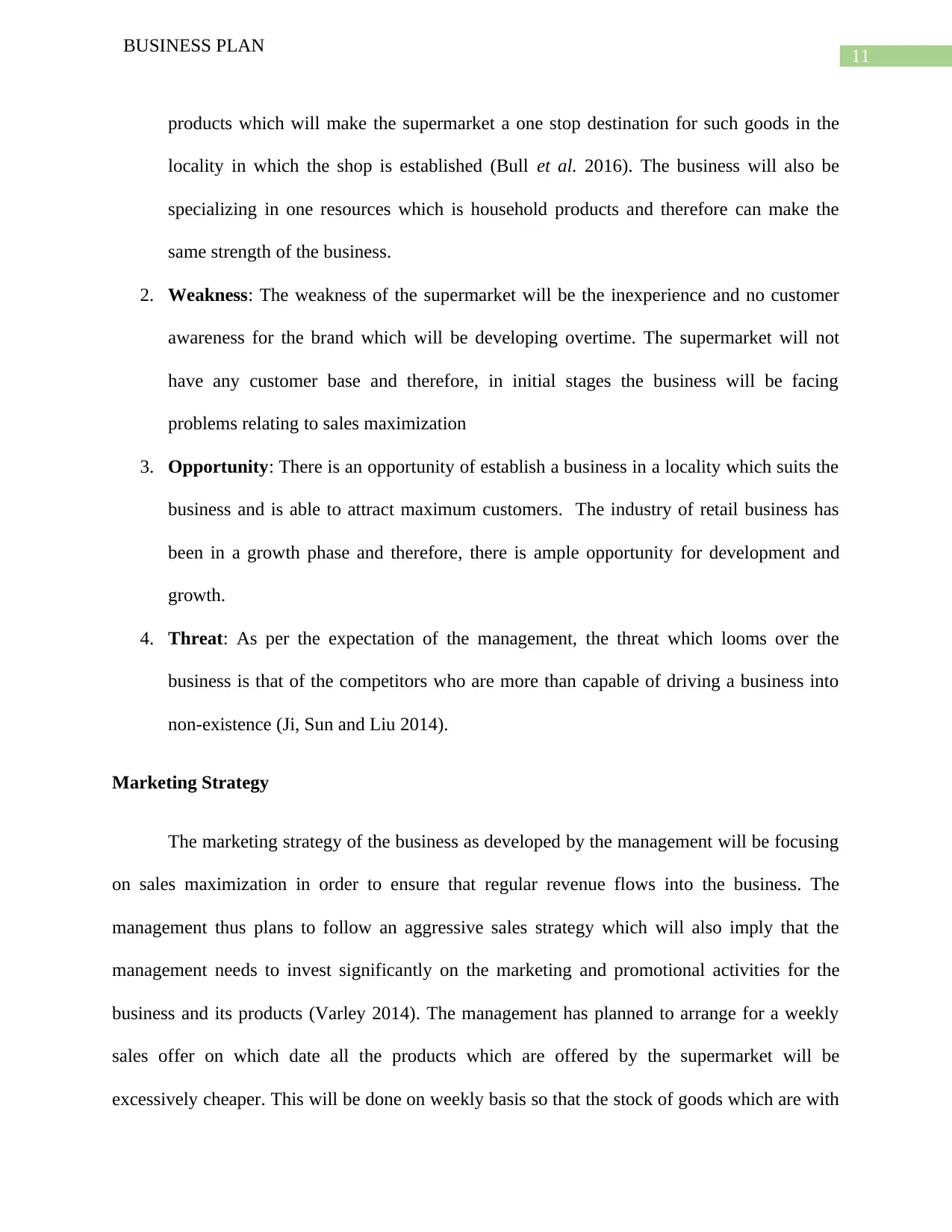
11
BUSINESS PLAN
products which will make the supermarket a one stop destination for such goods in the
locality in which the shop is established (Bull et al. 2016). The business will also be
specializing in one resources which is household products and therefore can make the
same strength of the business.
2. Weakness: The weakness of the supermarket will be the inexperience and no customer
awareness for the brand which will be developing overtime. The supermarket will not
have any customer base and therefore, in initial stages the business will be facing
problems relating to sales maximization
3. Opportunity: There is an opportunity of establish a business in a locality which suits the
business and is able to attract maximum customers. The industry of retail business has
been in a growth phase and therefore, there is ample opportunity for development and
growth.
4. Threat: As per the expectation of the management, the threat which looms over the
business is that of the competitors who are more than capable of driving a business into
non-existence (Ji, Sun and Liu 2014).
Marketing Strategy
The marketing strategy of the business as developed by the management will be focusing
on sales maximization in order to ensure that regular revenue flows into the business. The
management thus plans to follow an aggressive sales strategy which will also imply that the
management needs to invest significantly on the marketing and promotional activities for the
business and its products (Varley 2014). The management has planned to arrange for a weekly
sales offer on which date all the products which are offered by the supermarket will be
excessively cheaper. This will be done on weekly basis so that the stock of goods which are with
BUSINESS PLAN
products which will make the supermarket a one stop destination for such goods in the
locality in which the shop is established (Bull et al. 2016). The business will also be
specializing in one resources which is household products and therefore can make the
same strength of the business.
2. Weakness: The weakness of the supermarket will be the inexperience and no customer
awareness for the brand which will be developing overtime. The supermarket will not
have any customer base and therefore, in initial stages the business will be facing
problems relating to sales maximization
3. Opportunity: There is an opportunity of establish a business in a locality which suits the
business and is able to attract maximum customers. The industry of retail business has
been in a growth phase and therefore, there is ample opportunity for development and
growth.
4. Threat: As per the expectation of the management, the threat which looms over the
business is that of the competitors who are more than capable of driving a business into
non-existence (Ji, Sun and Liu 2014).
Marketing Strategy
The marketing strategy of the business as developed by the management will be focusing
on sales maximization in order to ensure that regular revenue flows into the business. The
management thus plans to follow an aggressive sales strategy which will also imply that the
management needs to invest significantly on the marketing and promotional activities for the
business and its products (Varley 2014). The management has planned to arrange for a weekly
sales offer on which date all the products which are offered by the supermarket will be
excessively cheaper. This will be done on weekly basis so that the stock of goods which are with
⊘ This is a preview!⊘
Do you want full access?
Subscribe today to unlock all pages.

Trusted by 1+ million students worldwide
1 out of 22
Related Documents
Your All-in-One AI-Powered Toolkit for Academic Success.
+13062052269
info@desklib.com
Available 24*7 on WhatsApp / Email
![[object Object]](/_next/static/media/star-bottom.7253800d.svg)
Unlock your academic potential
Copyright © 2020–2025 A2Z Services. All Rights Reserved. Developed and managed by ZUCOL.




